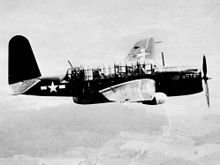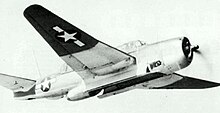
The Vought F4U Corsair is an American fighter aircraft that saw service primarily in World War II and the Korean War. Designed and initially manufactured by Chance Vought, the Corsair was soon in great demand; additional production contracts were given to Goodyear, whose Corsairs were designated FG, and Brewster, designated F3A.

A torpedo bomber is a military aircraft designed primarily to attack ships with aerial torpedoes. Torpedo bombers came into existence just before the First World War almost as soon as aircraft were built that were capable of carrying the weight of a torpedo, and remained an important aircraft type until they were rendered obsolete by anti-ship missiles. They were an important element in many famous Second World War battles, notably the British attack at Taranto, the sinking of the German battleship Bismarck, the sinking of the British battleship HMS Prince Of Wales and the British battlecruiser HMS Repulse and the Japanese attack on Pearl Harbor.

The Grumman TBF Avenger is an American World War II-era torpedo bomber developed initially for the United States Navy and Marine Corps, and eventually used by several air and naval aviation services around the world.

The Douglas TBD Devastator was an American torpedo bomber of the United States Navy. Ordered in 1934, it first flew in 1935 and entered service in 1937. At that point, it was the most advanced aircraft flying for the Navy; however, by the time of the US entry into World War 2, the TBD was already outdated.

The Douglas XTB2D Skypirate was a torpedo bomber intended for service with the United States Navy's Midway- and Essex-class aircraft carriers; it was too large for earlier decks. Two prototypes were completed, but the dedicated torpedo bomber was becoming an outdated concept, and with the end of World War II, the type was deemed unnecessary and cancelled.
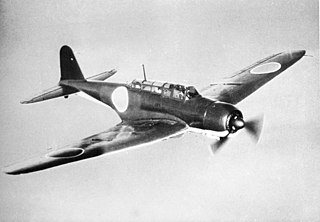
The Nakajima B5N was the standard carrier-based torpedo bomber of the Imperial Japanese Navy (IJN) for much of World War II. It also served as a high level bomber.

The Vought OS2U Kingfisher is an American catapult-launched observation floatplane. It was a compact mid-wing monoplane, with a large central float and small stabilizing floats. Performance was modest because of its low-powered engine. The OS2U could also operate on fixed, wheeled, taildragger landing gear.

The Vought F7U Cutlass is a United States Navy carrier-based jet fighter and fighter-bomber designed and produced by the aircraft manufacturer Chance Vought. It was the first tailless production fighter in the United States as well as the Navy's first jet equipped with swept wings and the first to be designed with afterburners.

The Boeing XPBB-1 Sea Ranger was a prototype twin-engined flying boat patrol bomber built for the United States Navy. The order for this aircraft was canceled, to free production capacity to build the Boeing B-29, and only a single prototype was completed.

The Consolidated PB4Y-2 Privateer is an American World War II and Korean War era patrol bomber of the United States Navy derived from the Consolidated B-24 Liberator. The Navy had been using B-24s with only minor modifications as the PB4Y-1 Liberator, and along with maritime patrol Liberators used by RAF Coastal Command, this type of patrol plane was proven successful. A fully navalized design was desired, and Consolidated developed a dedicated long-range patrol bomber in 1943, designated PB4Y-2 Privateer. In 1951, the type was redesignated P4Y-2 Privateer. A further designation change occurred in September 1962, when the remaining US Navy Privateers were redesignated QP-4B.

The PB2Y Coronado is a large flying boat patrol bomber designed by Consolidated Aircraft, and used by the US Navy during World War II in bombing, antisubmarine, medical/hospital plane, and transport roles. Obsolete by the end of the war, Coronados were quickly taken out of service. Only one known example remains, at the National Naval Aviation Museum at Naval Air Station Pensacola, Florida. Before WW2 large flying boats were important for long distance international routes, as the ability to land on water without a land-based airstrip was useful. It proved to be good supporting aircraft in the Pacific War, which often required transport across long distance of oceans in harm's way, to places with no prepared airstrips.
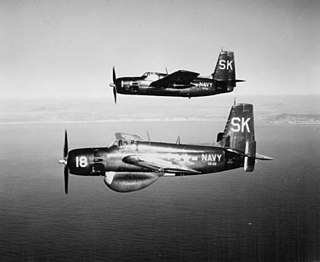
The Grumman AF Guardian is the first purpose-built anti-submarine warfare (ASW) carrier-based aircraft to enter service with the United States Navy. It consisted of two airframe variants, one for detection gear, the other for weapons. The Guardian remained in service until August 1955, when it was replaced by the twin-engined Grumman S-2 Tracker. The Guardian was the largest single-engine piston-powered carrier aircraft ever to see service.

The Fairey Spearfish was a British carrier-based, single-engined, torpedo bomber/dive bomber that was ordered from Fairey Aviation for the Fleet Air Arm during World War II. Designed during the war, the prototype did not fly until July 1945. Much larger than earlier naval bombers, it was designed for use aboard the large Malta-class aircraft carriers that were cancelled after the war and was itself cancelled thereafter. Seven prototypes were ordered, but only five were built, of which four actually flew. They were mostly used for experimental work until the last aircraft was scrapped in 1952.

The Douglas BTD Destroyer is an American dive/torpedo bomber developed for the United States Navy during World War II. A small number had been delivered before the end of the war, but none saw combat.

The Arado Ar 195 was a single-engine prototype carrier-based torpedo bomber, built by the German firm Arado for service on the German aircraft carrier Graf Zeppelin, during World War II.
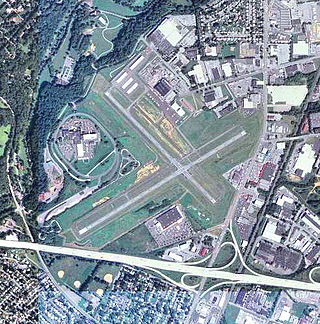
Allentown Queen City Municipal Airport, also known as Queen City Airport, is a public airport in Lehigh County, Pennsylvania, on Lehigh Street two miles southwest of Allentown, Pennsylvania. The airport is owned by the Lehigh-Northampton Airport Authority (LNAA).

The Edo OSE was a 1940s American single-seat multi-role floatplane designed and manufactured by the Edo Aircraft Corporation.
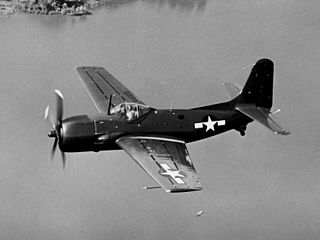
The Curtiss XBT2C was a prototype two-seat, single-engined dive/torpedo bomber developed during World War II for the United States Navy. Derived from the Curtiss SB2C Helldiver dive bomber, it was an unsuccessful competitor to meet a 1945 Navy specification for an aircraft to combine the roles that previously required separate types. Unlike the other competitors, the XBT2C was designed to accommodate a radar operator.
The Vought V-326 was an American experimental aircraft used by Pratt & Whitney as a high altitude engine test bed.

